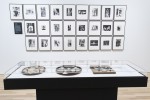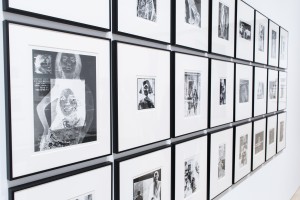Through a former teacher’s artwork, a slice of UCLA history has resurfaced in Westwood.
Originally on view at the Museum of Modern Art in New York, an exhibit of the artistic works of Robert Heinecken has come to UCLA’s Hammer Museum. Open until Jan. 18, “Robert Heinecken: Object Matter” will showcase a wide range of mediums from modern sculptures to photographs taken without cameras.
The Daily Bruin’s Maryrose Kulick spoke with the curator of the exhibit, Eva Respini, about how the collection was compiled, the details of Heinecken’s work and his relationship with UCLA.
Daily Bruin: Why did the Hammer decide to showcase Robert Heinecken’s work?
Eva Respini: I would think it’s because of the resonance that Heinecken’s work has in the L.A. area, specifically his relationship to UCLA. … He founded the photography department in the 1960s at UCLA and taught there until 1991, so he really had kind of an outside presence and legacy. I think the Hammer felt it was really important to represent that history within their own museum walls.
DB: How was the exhibit compiled, and what was that process like?
ER: It took about two years from beginning to end, from the early conceptualization to finally mounting it on the walls at the Museum of Modern Art (MoMA) here in New York and then traveling to the Hammer.
I started by seeing as much as I could see, and really researching Heinecken’s career, trying to understand the artworks.
I knew from the beginning that I wanted to tell the story of how he became an artist, how his work developed and really to focus on this idea … of coming from outside of photography and thinking about photography through untraditional means. … As we make selections for the work in the show, we take the most important works, the best works, but also the works that really illustrated this idea of him as a visionary figure.
DB: Can you describe some of the pieces that are being showcased?
ER: (There’s) a selection of altered or manipulated magazines that are in the central gallery at the Hammer. They are actual magazines that circulated in the world – everything from “Vogue,” “Harper’s Bazaar,” “Reader’s Digest,” etc., that Heinecken manipulated. He manipulated them by either photolithography – by printing images on top of these existing pages in the magazine – or he would cut things out using an X-Acto knife, or he would disassemble magazines and then reassemble them using different pages from different magazines to create juxtapositions.
The way in which he manipulated them I think is extremely telling of his view on American culture, (by his) interweaving of sex and violence (in the works with) this obsession of sex on one hand, then on the other hand, the way in which sex is used to practically sell everything. … (The magazines are) a really key element in the show, because (they are) from where everything else in the show emanates.
DB: What were some of the most defining techniques that Heinecken used in his works?
ER: The thing about Heinecken was that he was completely unafraid of experimenting, and (when) one walks through the show, you’ll see that virtually every medium is represented. There are traditional black and white photographs, collage, photolithography, photographic emulsion on canvas, works that appear almost like paintings, sculpture installation, magazines, slideshows.
Basically, Heinecken wasn’t trained in photography traditionally. In fact, he hardly ever picked up a camera in a traditional sense … I think where he really excelled was in the non-traditional, non-camera ways of making images, and I think that’s what makes him so interesting and why it’s even more interesting that he founded the (UCLA) photography department, (coming) from such an untraditional background.
DB: What would you say the exhibit has to offer to UCLA students today?
ER: I would say that the link to UCLA, the fact that Heinecken has such deep roots at UCLA, is definitely part of the university history. He was a big part of it, not just as a teacher, but he was also very crucial in forming a photographic collection which eventually went to the Hammer as a way for professors at UCLA to teach the history of photography.
For me, probably the most important thing about Heinecken is thinking about how (he used) found images … which in his day were through magazine or through TV. That strategy is so common today, and we take it for granted. It wasn’t necessarily in the time that he lived and (when) he was making art, and for me, that’s really the mark of an artist who was way ahead of his time.
– Maryrose Kulick, Daily Bruin contributor

